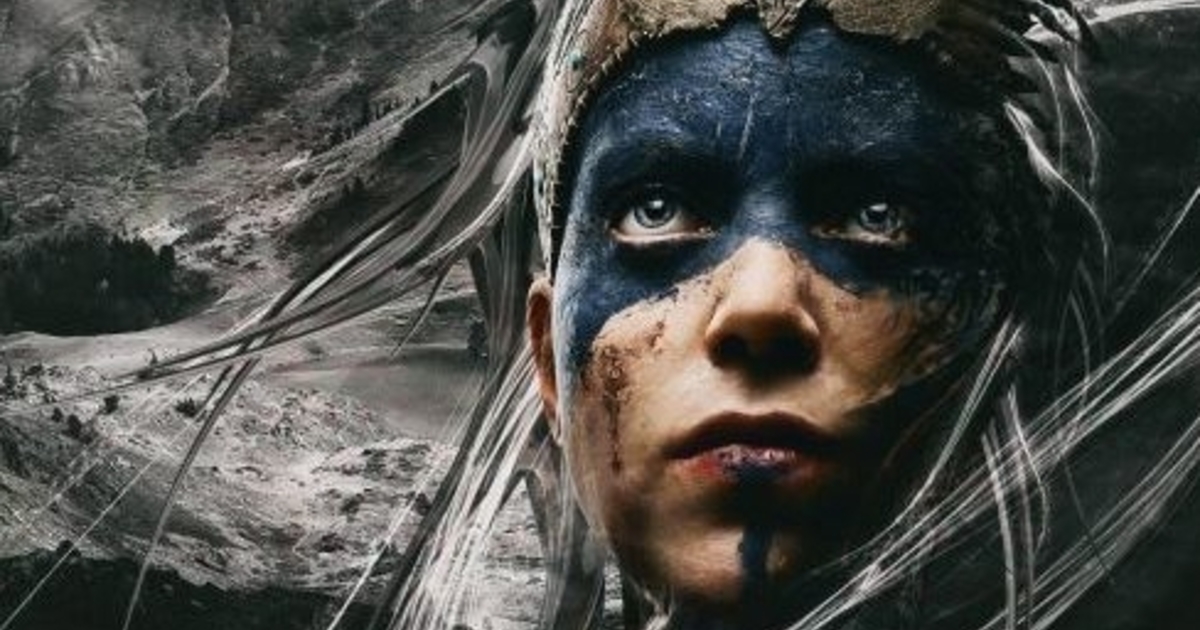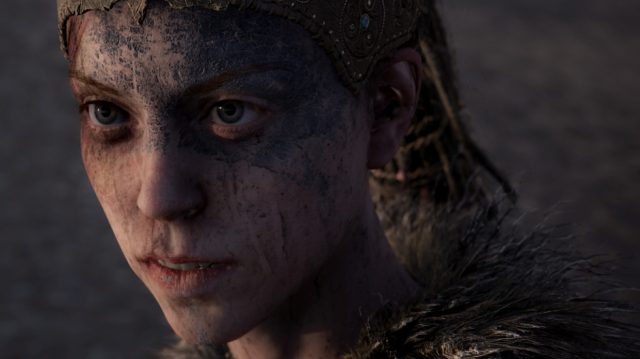
Video games have reached a level of maturity that is, quite frankly, very impressive. This isn’t a new fact, by any means, but it seems that every year brings notable steps forward. While a lot of this is thanks to independent developers and their fresh ideas, lower budgets and unmatched freedom, major developers haven’t shied away from mature subject matter as of late. This is especially true for the United Kingdom’s Ninja Theory studio, which just released a port of its dark fantasy action/adventure game, Hellblade: Senua’s Sacrifice, onto the Xbox One platform.
One thing that Hellblade isn’t is forgettable. With it, Ninja Theory (who’ve developed some really fantastic games, like Enslaved: Odyssey to the West, DmC: Devil May Cry and Heavenly Sword) attempted to do something different while dealing with a very sensitive subject matter. The result is a rich, detailed, enjoyable and immersive video game that does a very good job of tackling mental illness by way of psychosis.
Hellblade: Senua’s Sacrifice stars the titular Senua, a young, dreadlocked woman who’s dressed in somewhat tribal garb. She exists in a Nordic themed world, where talk of Norse gods spills out of partially hidden rune stones that act as the game’s collectibles, not to mention its storytellers. In this regard, it’s very similar to Sony’s new God of War game, which is heavily entrenched within Norse mythology. Both games share similar characters, who either appear inside of them or within the stories that are told during their run times.
As a child and young adult, Senua was told that she was cursed, and was hidden away by her ruthless father following the passing of her mother, whose darkness ate her up inside. Unfortunately, our young heroine suffers from this very same darkness, and it not only causes her to hallucinate, but also leads to her hearing voices at almost all times. Thus, those entering into this experience must know that they’re going to be controlling and listening to someone who’s out of sorts mentally. A woman who speaks to herself and learns a lot about her quest from the voices in her head, including that of her deceased lover. However, while they may aid her at times, they spend more time torturing her than doing anything else.

It is this former lover, Dillion, who acts as the reason for this quest. Losing him has sent Senua into the depths of Hel, where she hopes to battle Hella. Victory within said battle, it is thought, will then lead to his soul being returned to the head that she carries on her waist.
Getting there will not be easy, however, because Hel is locked away behind doors bearing rune based locks. Doors that lead to different beasts and creatures that protect the realm, including a master of illusion, a fire god and a dangerous hell hound. These particular foes act as the game’s bosses, but they are not the only ones with which you’ll do battle.
Simply put, Hellblade is a Dark Souls-esque narrative action/adventure game with heavy dark fantasy elements. That’s not all it is, though, because what we have here is an experience that is quite heavy on puzzles.
In many instances, unique runes show up on doors as hints that tell you what to look for. To unlock these passageways, one must search nearby areas for environmental facets that create such designs, be it something that looks like the letter N or a slightly more elaborate shape. Think things like close together trees, cracks in a fence, or the outline of a former fire.
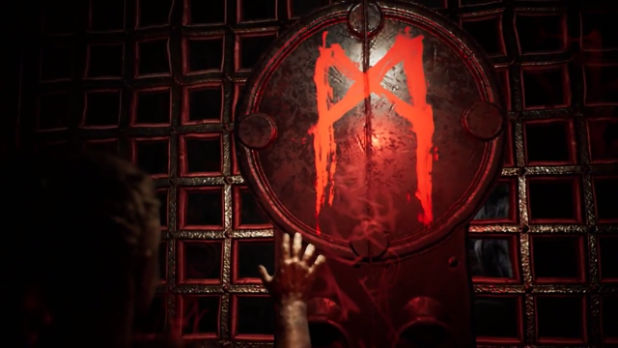
In order to discover and collect each rune, one must stand at the right angle (so as to see it fully), then press the right trigger button so that Senua begins to focus. Her focus is the only way you can actually crack these unique codes and progress further, and it’s relatively easy to use although it can be finicky at times. These puzzles aren’t always easy, either, and finding their runes can take work, including altering the environment by using light and flame. This isn’t the only facet that focusing aids, though, because it can also allow you to restore things that have recently disappeared back into reality, be it pieces of a bridge, a staircase or something like that.
Early on, puzzles also require emblems to be lined up, and will sometimes introduce special gates into the fray. These are things that you walk through to alter the world around you. For example, walking through one may change things so that a previously locked gate is now open, or a previously invisible stair case has been summoned into existence. They’re not nearly as common later on, but that’s all right.
While many will expect lots of swordplay and challenging combat from a game that’s been compared to Dark Souls and labeled as an action title, Hellblade doesn’t throw a ton of enemies at you. No, this is a game that almost has more puzzles than it does physical battles. That’s not to say there’s not a decent amount of fighting; it’s just to say that this isn’t much like DmC was, or even like Enslaved ended up being. Combat is spaced out according to the narrative, and it often plays second or third fiddle to the exploration, storytelling and puzzles. It all works, though, because Hellblade: Senua’s Sacrifice is a cinematic affair and it’s meant to be more of an experience than anything else.
When combat does come into play — and it will on quite a few different occasions over the 8 or so hours you’ll spend with this title — it does so in a way that brings Dark Souls to mind, although the learning curve isn’t as high thanks to three different difficulty options. Senua must fight against multiple types of foes, ranging from basic knight-like creatures to shielded variations and those carrying heavy axes or dual wielding weaponry. She succeeds at this by pressing the A button to dodge, then striking when an opening presents itself, and can also utilize a trigger button to block and parry. Pressing X initiates a light attack, which is quick and somewhat deadly, while pressing Y unleashes a heavy attack that is slower and more deadly, and pressing B makes her kick, which is helpful against shielded enemies.
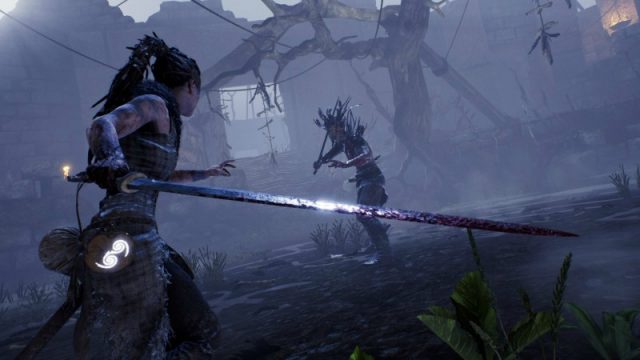
Enemies can hit hard, and if enough damage is taken our heroine will fall to the ground and leave herself open for a deadly attack. If she gets up before that happens, she can continue to fight, but may be slow and encumbered if she’s taken a good amount of damage or fallen more than once before. She’s not impervious to death, either, and it isn’t very difficult to die here. In fact, the campaign introduces a permadeath feature early on, by telling players that each time Senua falls, the darkness that curses her will encroach upon her arm and move towards her head. Once there, it will kill her for good, they say. The thing is that this feature is never really enforced, and is most-likely just a way to up the tension ante and make players sweat.
It certainly had me going, and also had me very worried at first. I don’t like the idea of permadeath in video games, nor do I enjoy or ever play roguelikes. Thankfully, it’s more of a scare tactic than anything else.
This doesn’t mean that Hellblade is ever an easy affair. It’s not. While it (thankfully) never reaches the level of any of the Dark Souls or Bloodborne games, it packs a good amount of challenge, even on its easy difficulty. Fights are often carried out against one or two foes at a time, but later engagements throw more at you. Sometimes it’ll feel like they won’t stop coming, but they will…eventually.
To be honest, I had originally decided to skip this one because of the comparisons to Dark Souls that I’d read online. I’m glad that I didn’t, though, because while it’s not like many other games that I’ve ever played (or normally bother with), it’s turned out to be one of the best and most memorable experiences I’ve ever had. It helps that the main character is a mix between a strong woman and a flawed and ill human being, who’s unsure of what to believe and what, exactly is real. The way that Hellblade tackles mental illness is impressive, and I say that as someone who has dealt with it for more than 22 years.
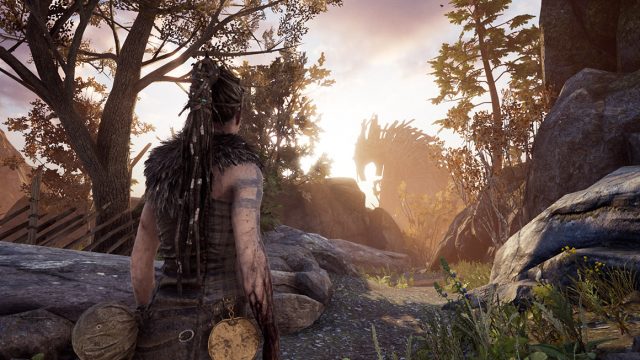
This isn’t a perfect experience, however, nor is it as good as it could’ve been. Although some of the puzzles are pretty smart, there’s far too many of them and they really slow the experience down. It can be especially frustrating when you feel like you’ve explored every inch of a nearby area, but have yet to find the rune that you need to progress. I know, because it annoyed me on more than one occasion.
There was also one segment that seemed to glitch on me, to the point where I didn’t think I was going to be able to progress. It came about approximately six hours in, as I was attempting to complete a special trial that presented two different masks, each of which would allow me to turn the world light or dark. As you can expect, the light world was nice, while the dark world was rainy, gloomy and in disrepair. The idea was to navigate both and switch between them when necessary, in order to get inside and to the top of a tower. In order to do so, I had to find a rune (which was easy), then open the door that it unlocked. Well, for whatever reason, said door would not open for me and it took multiple tries and reloads before it did, to my relief and surprise.
I looked that section up and read about it on two different FAQs. Both said that the door was to simply open when I got close to it, but it wouldn’t, no matter what I tried. Hell, I even watched a YouTube video that made it look easy. It was during this research that I learned about some bugs that were present in the original PS4 release, but were apparently all patched out before the Xbox One received its port. I was scared that I had encountered one that had slipped through, but got lucky.
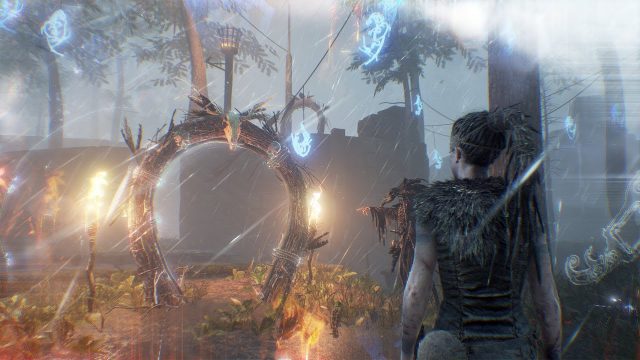
Originally, another complaint of mine was going to be that Senua moved too slowly. However, after fiddling with the options and control scheme (which allows you to choose custom button assignments for most actions), I was pleased to discover that I could not only switch the run command from LB to L3, but could also toggle it so that Senua would run without me needing to hold the joystick in. That was a nice discovery, but even then her running speed left something to be desired.
It’s presentation where this thing really shines, though, and boy does it ever. Hellblade: Senua’s Sacrifice has got to be one of the absolute best looking games on Xbox One, not to mention one of the nicest looking titles of the generation at large. It’s truly beautiful, with tons of depth and detail, the likes of which you rarely see. God of War may have it beat, but not by much, thanks to some incredible art design, direction and effort. Senua is incredibly detailed, as are the environments that she travels through, and though this is Hel we’re talking about, it’s pretty easy on the eyes at most times. During others, it offers some pretty incredible imagery, especially when the Sea of Souls comes into play.
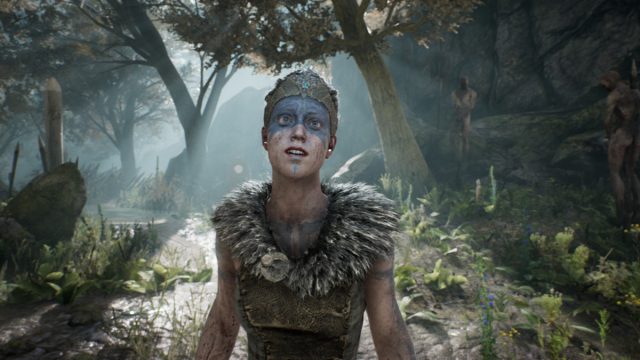
Senua’s hallucinations and visions also add to an already great achievement, as do her cuts, scrapes and bruises. It’s the voices that are most unique, though, and they’re what you’ll likely remember most about this game. They really up the ante, increase one’s tension and make one think, while showcasing Senua’s mental illnesses in realistic fashion. Not once does this experience make fun of, exaggerate or ridicule those who suffer, either, and I applaud the team behind it for all of the insight and maturity they approached this difficult subject with. Of course, it also helps that the voice acting — like the writing and sound effects — happens to be top notch.
At the end of the day, Hellblade: Senua’s Sacrifice is a real winner. It may have a few too many tedious puzzles, may be a bit too finicky for its own good and might have a couple of odd glitches, but it’s a standout and a near masterpiece regardless of those flaws. This is a game that you won’t soon forget, and one that you need to play, so long as you’re a mature gamer who is able to approach things with an open mind. Just be warned that the ending isn’t all it could’ve been, despite a pretty badass final battle that incorporates some amazing licensed music to go along with an already impressive orchestral score.
**This review is based on the Xbox One version of the game. We played it on an Xbox One X, and that allowed us to choose between modes that sharpened the visuals, heightened the resolution and improved the frame rate.**

